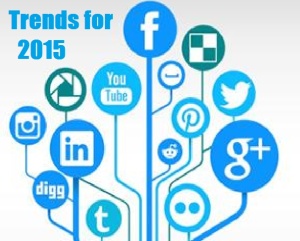As 2014 is winding down, it’s time for businesses to start planning their marketing strategy for next year, in a context where the business scenario is continuously changing at the speed of technology. Firms ought to adapt themselves to online marketing, whether they like it or not . Many marketers are already chasing their daily meanderings in terms of “likes”, “shares”, “tweets”, click-through rates and ever more immediate metrics. All these interesting developments on internet are allowing businesses to differentiate themselves to get ahead of their rivals. Smart marketers are regularly collecting social data to offer more personalised, relevant and wanted content toward customers. As a matter of fact, 78% of marketers believe that data-driven marketing via digital channels is the path to new growth (American Marketing Association, 2014). In a sense, web 2.0 has helped businesses to share relevant information about their branded products, service features and propositions that may have generated leads and conversions. Nowadays, some of the best businesses are focusing their attention on inbound marketing techniques as they diligently segment their audiences and target them with online marketing endeavours through different social platforms:
- Social Media Marketing: It is in the businesses’ interest to get to know about the demographic profile of customers. In addition they should be aware of the latest contemporary trends and conversations that are happening on social networks. Businesses ought to present themselves in a way that feels native and endemic to customers. One of the main ways that companies are establishing authority and trust among their consumers is by consistently creating high quality content that may provide useful and interesting insights to audiences. Through integrated marketing communications involving social media channels, companies are steadily building a strong rapport with customers, which will inevitably help them to develop brand equity.
- Ad Re-Targeting: Today, businesses use content marketing tactics by producing valuable, engaging content that is designed for specific customers. Content on social media is becoming more conversational in nature. Consumers value those brands that show their human face. They consider them as trustworthy and authentic. Therefore, businesses communicate with their targeted audiences to build fruitful relationships with loyal followers. Several marketers are increasingly becoming quite proficient in re-targeting customers. Retargeting works by utilising browser cookies that track websites that are visited by internet users. Once the users leave these sites, the products or services they viewed will be shown to them again in advertisements, across different websites. Therefore, ad retargeting works to increase the overall conversion rate by reminding consumers of the product or service they had viewed. This keeps the brand and the product at the top of the consumers’ minds. Many studies have indicated that simple exposure to brand names and logos may ultimately lead to purchase decisions. Even if there’s no instantaneous purchase, an increased brand awareness can really pay off in the long run.
- Search Engine Optimisation: The goal of Google, Bing and other search engines is to provide their users with the most relevant and highest quality content. It goes without saying that, these days social signals may play a key role in organic search rankings. As more people share content through social media channels, it is very likely that the most popular content will be featured in search engine results. It’s no coincidence that the top-ranking search results tend to have lots of social shares, while those ranked lower have fewer. Moreover, social shares may often serve as a stamp of approval or can be considered as a trust signal for visitors. That’s why so many businesses are installing social share plugins and encouraging consumers to share their content, as much as possible.
- Mobile Marketing: We are living in an era that is characterised by mobile readiness, responsive designs as well as the revival of ‘going local,’ Businesses are encouraged to produce content that “scales down” on mobiles. Such content may include marketing emails, eNewsletters, websites, social posts and the like. According to (Forbes, 2013), “87% of connected devices sales by 2017 will be tablets and smartphones”. Whether businesses opt to create an alternative mobile version of a website or decide to utilise responsive web design, it’s important for them to provide a positive experience for those internet users that are browsing via mobile devices.
- Video Marketing: When it comes to potential reach, video is peerless. YouTube is currently receiving more than one billion unique visitors every month – that’s more than any other channel, apart from Facebook. For the record, “one out of three Britons view at least one online video a week – that’s a weekly audience of more than 20 million people in the UK alone” (Guardian, 2014). Of course, it’s vital for businesses to offer content that is easy to digest; if not, consumers will simply move on. Apps such as Twitter’s Vine (with its six-second maximum clip length) have dramatically increased the opportunity for businesses to upload social videos having authentic content.
In a nutshell, this contribution suggests that next year many businesses will increasingly resort to digital marketing tactics to reach their individual consumers. eMarketer (2014) anticipates that in the next 12 months, the marketing budget that is allocated to social media will rise to 13.2% (from 9.4%). It is imperative that marketers learn how to engage with online visitors through effective, relevant content. Notwithstanding, it may appear that electronic marketing has changed consumers’ mindsets and their behavioural attitudes toward businesses. Perhaps, there’s an opportunity for businesses to leverage themselves through faster adaptations, shorter lead times and always-on, real-time marketing.
Digital & Social Articles on Business 2 Community
(397)








